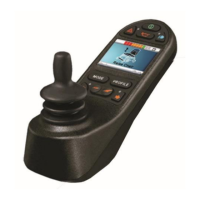This programming means that the Up movement will be inhibited when the Inhibit 20 input is in Band 0, i.e. one end of recline
travel, and that the Down movement will be inhibited when the Inhibit 4 input is in Band 3, i.e. the other end of the recline
travel. Referring the Band diagram above, it can be seen that by programming ISM-8 Upper Level Threshold and ISM-8 Lower
Level Threshold, then the actual angular range of the recline mechanism is adjusted.
ISM-8 – INPUTS
5.3.1 LOWER LEVEL THRESHOLD
This sets the level of the threshold between Band 0 and Band 1 for a particular Inhibit Input on the ISM-8. See Inhibits Explained
for more details on ISM-8 inhibits and bands.
The programmable range is 0% to 100% in steps of 1%.
5.3.2 MIDDLE LEVEL THRESHOLD
This sets the level of the threshold between Band 1 and band 2 for a particular Inhibit Input on the ISM-8. See Inhibits Explained
for more details on ISM-8 inhibits and bands.
The programmable range is 0% to 100% in steps of 1%.
5.3.3 UPPER LEVEL THRESHOLD
This sets the level of the threshold between Band 2 and band 3 for a particular Inhibit Input on the ISM-8. See Inhibits Explained
for more details on ISM-8 inhibits and bands.
The programmable range is 0% to 100% in steps of 1%.
5.3.4 DEBOUNCE TIME
This sets a debounce time for the Inhibit input. Debounce is the amount of time the input must be stable before a new
condition is registered. This is particularly useful if mercury switches are being employed and eliminates the effect of
“splashing” across the contacts.
The programmable range is 0ms to 4000ms in steps of 50ms.
5.3.5 INHIBIT TYPE
The ISM-8 has 16 inhibit inputs assigned number 18 to 33. Each Inhibit input can be set to accept a signal from either an active
or passive sensor.
If set to Active, then a voltage signal in the range 0-3.3V will be expected, where 0V equates to 0% and 3.3V equates to 100%.
If set to Passive then a 10kOhm variable resistor will be expected, where 0Ohm equates to 0% and 10kOhm equates to 100%.

